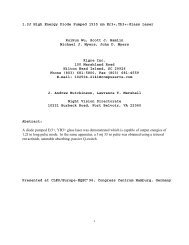Doped Phosphate Laser Glasses - Kigre, Inc.
Doped Phosphate Laser Glasses - Kigre, Inc.
Doped Phosphate Laser Glasses - Kigre, Inc.
Create successful ePaper yourself
Turn your PDF publications into a flip-book with our unique Google optimized e-Paper software.
3.2 QX/Nd Glass<br />
A Nd 3+ doped chemically strengthened glass laser test was conducted using a 10<br />
mm diameter by 160 mm long rod pumped with two KS36 lamps in a <strong>Kigre</strong> FD106SK<br />
pump chamber with a discharge pulse duration was 2ms. The laser resonator<br />
consisted of a high reflector with a 10m curvature and a flat output coupler<br />
with a reflectance of 60% at 1.05µm. The pump repetition rate was fixed at 5<br />
Hz during the initial stage of the test. The input power was increased by<br />
elevating the input voltage. After the input voltage had reached its maximum,<br />
the repetition rate was increased in order to input more power into the laser<br />
glass rod until the maximum power supply discharge capability of 3KW was<br />
reached.<br />
Figure 5 shows that these two stages exhibit slope efficiencies of 5.4% and<br />
3.9%, respectively. It is believed that the decrease in slope efficiency<br />
exhibited in the second test stage is a result of thermal lensing. The<br />
thermal lensing is a result of the high temperature gradient which extends<br />
from the rod center to the barrel surface for such a high power pump<br />
condition. This lensing appears although QX/Nd laser glass exhibits a low<br />
temperature coefficient of optical path length of 4.5 x 10 6 k -1 .<br />
7

















